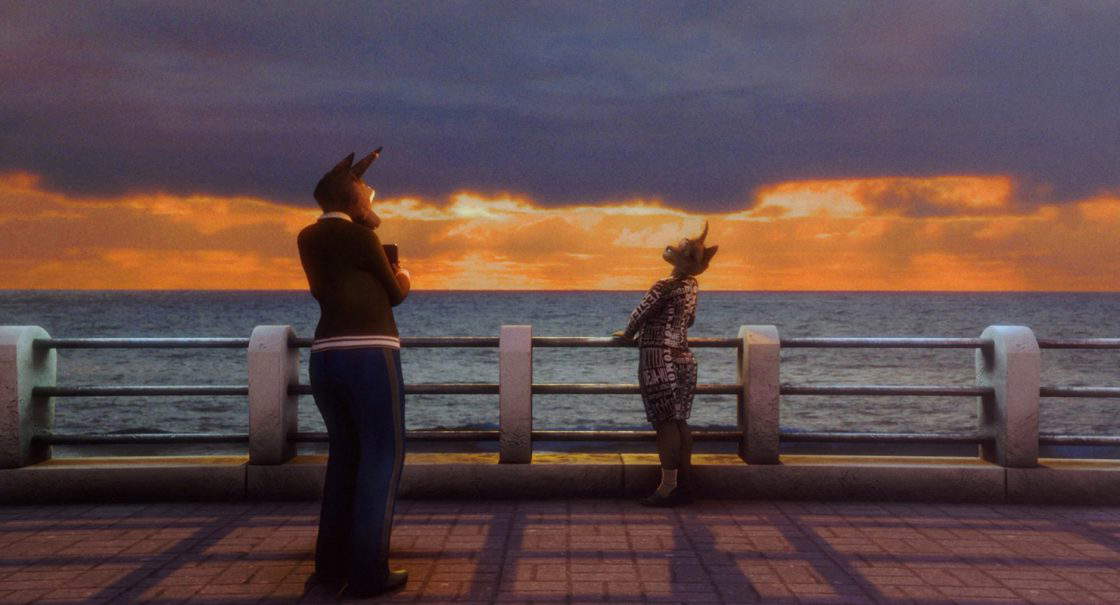For My Best Family is a new exhibition project conceived by artist Meriem Bennani and commissioned by Fondazione Prada. Combining a new site-specific installation with an art film co-directed with Orian Barki, For My Best Family explores ways of being together in sociopolitical contexts by representing them in public or intimate ways. This project is the most ambitious Bennani has ever done in terms of complexity, size of the works and length of the creative process that took more than two years to complete. It follows a line of programming that Fondazione Prada has traced over more than three decades, collaborating with international artists in the creation of utopian projects that are both conceptually and exhibitionally complex.
Meriem Bennani(Morocco, 1988) explores the potential of storytelling by amplifying reality through the use of fantastical imagery and humor and the blending of languages typical of YouTube videos, reality TV, documentaries, animation, and the aesthetics of major productions. Throughout his career, Bennani has developed an evolving practice characterized by immersive films, sculptures, and installations made with a wide flexibility to question contemporary society and its fragmented identities, issues of gender, and the ubiquitous power of digital technologies.
As Bennani explains, “one of the central themes of For My Best Family is knowing how to be together, wondering where a person begins and ends. The film focuses on a mother and daughter learning to be together, while in the installation the concept is more abstract and refers to collectivity in a broader sense, nonverbal moments of encounter in which there seems to be a force that takes the form of a multiform body. Like a puppet, the multitude becomes a single thing, a single voice, a single way of acting, and everyone knows exactly what they have to do at that moment, rhythmically or singing, for example how to use their bodies and stomp their feet. I like to use animation as a means of questioning togetherness and what it means to be alive.”
For Fondazione Prada Bennani developed a multisensory environment on the two levels of the Podium. On the ground floor, Sole crushing is a large mechanical installation that animates 192 flip-flops and flip-flops into a “ballet-symphony-revolve” and a musical composition. The soundtrack was composed in collaboration with music producer Reda Senhaji known as Cheb Runner. This complex kinetic system is conceived as an archipelago of polyphonic ensembles in which a multitude of slippers are arranged in different conformations: two “orchestras,” two spiral sculptures, and a central island. Each object is connected to a pneumatic system that makes it mobile, alive and breathing and to a surface characterized by various materials that, as in a percussion instrument, amplifies the sound of the element that strikes it. This playful and organic space evokes states of general catharsis, chaotic events or structured collective rituals such as Moroccan musical traditions including deqqa marrakchia, architectures intended for entertainment such as stadiums, conditions of delirium or hallucination, and forms of protest.
The second floor of the Podium hosts a movie theater-like setting to screen For Aicha, a new art film directed by Orian Barki and Meriem Bennani and made with creative production by John Michael Boling and Jason Coombs. Set in New York City, Rabat and Casablanca, in a world populated by anthropomorphic animals and suspended between realism, autobiography and fiction, this work is the culmination of a long creative process that blends the languages of documentary and 3D animation.
For Aicha follows Bouchra, a 35-year-old Moroccan filmmaker living in New York City. The jackal-like character is narrated as she writes an autobiographical film that addresses the impact her homosexuality has had on her mother Aicha, a cardiologist jackal living in Casablanca. The story mixes fiction-the film within the film directed by Bouchra-with an adaptation of recorded conversations that really happened between Bennani and his mother. With tenderness and humor, both “Bouchra the director” and “Bouchra the character” try to understand the nuances of love and pain in the mother-daughter relationship in order to move on with their lives. Bennani’s decision to use animated animals in this and previous works is a deliberate way to get complicated messages across by resorting to seemingly innocuous imagery. The narrative form of animation thus becomes a powerful tool for addressing current and controversial issues in an inventive and engaging form.
For all information, you can visit the official website of the Prada Foundation.
Pictured: Orian Barki, Meriem Bennani, John Michael Boling AND Jason Coombs, image from For Aicha (2024), Courtesy of the artist
 |
| Meriem Bennani at Fondazione Prada with the project "For my best family" |
Warning: the translation into English of the original Italian article was created using automatic tools. We undertake to review all articles, but we do not guarantee the total absence of inaccuracies in the translation due to the program. You can find the original by clicking on the ITA button. If you find any mistake,please contact us.